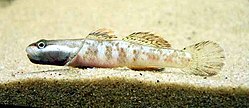| Rhinogobius | |
|---|---|
 | |
| Rhinogobius duospilus | |
| Scientific classification | |
| Kingdom: | Animalia |
| Phylum: | Chordata |
| Class: | Actinopterygii |
| Order: | Gobiiformes |
| Family: | Oxudercidae |
| Subfamily: | Gobionellinae |
| Genus: | Rhinogobius T. N. Gill, 1859 |
| Type species | |
| Rhinogobius similis T. N. Gill, 1859 | |
| Synonyms | |
PseudorhinogobiusZhong & Wu, 1998 | |
Rhinogobius is a genus of primarily freshwater gobies in the family Oxudercidae, native to tropical and temperate parts of eastern Asia. [1] Most are small, streamlined in shape, and often sexually dimorphic. Few are of commercial importance, but R. duospilus is fairly widely traded as an aquarium fish.



